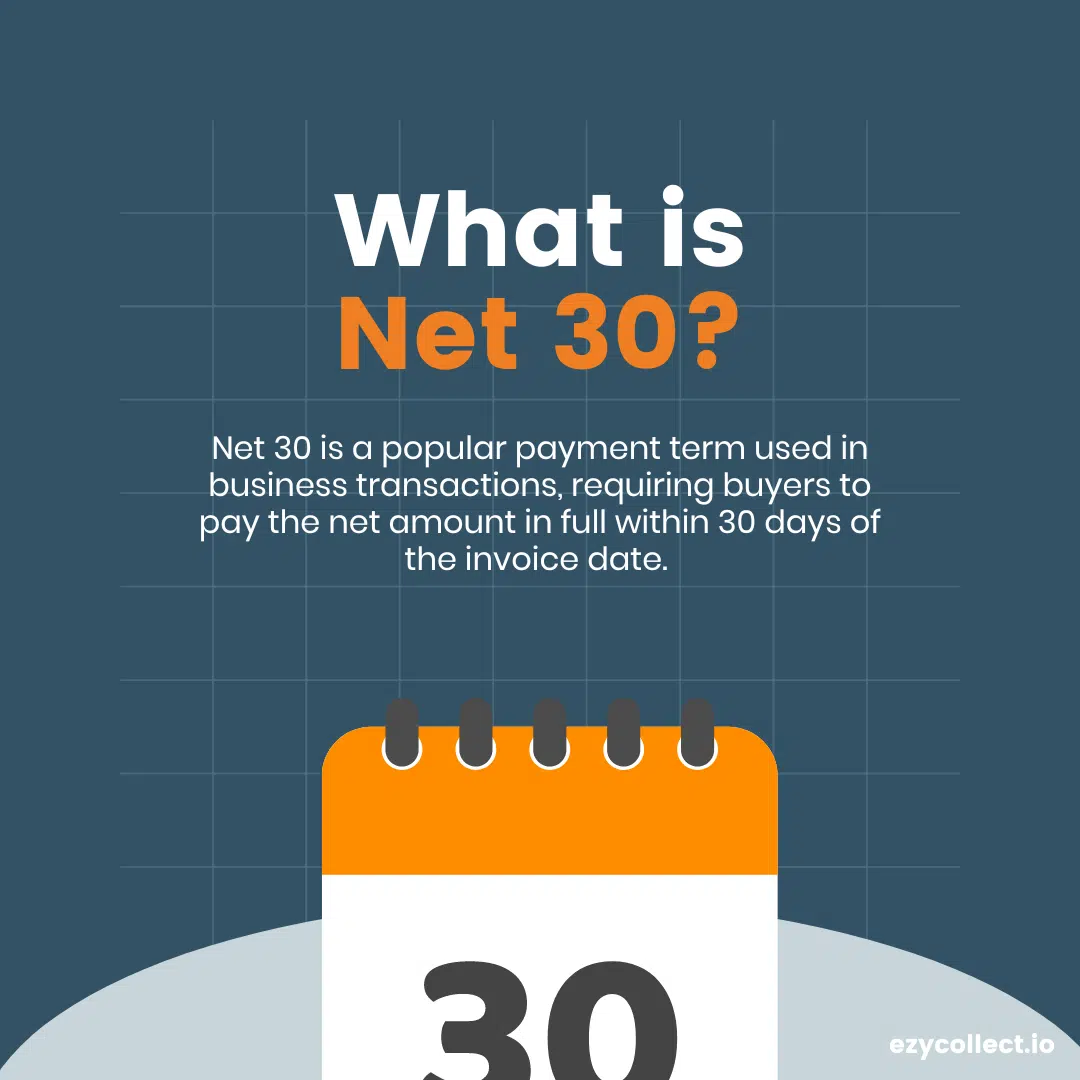Understanding Net 30 Payment Terms
Definition and Overview
Net 30 is a friendly agreement between a buyer and a seller.
It means the buyer has 30 calendar days from the invoice date to settle the full payment for the goods or services provided. This payment practice is a staple in business-to-business (B2B) transactions and offers both parties significant advantages.
For buyers, Net 30 gives you that much-needed breathing room to manage your finances. For sellers, extending a Net 30 payment term can attract more customers by providing flexibility in payment terms.
Key Features of Net 30
Understanding these features helps both buyers and sellers know what to expect and plan their financial strategies accordingly.
- 30 Calendar Days: The payment period starts from the invoice date, not the delivery date, and includes weekends and holidays.
- Invoice Date Matters: The invoice date marks the beginning of the 30-day payment period.
- Full Payment Expected: The buyer must pay the full amount within 30 days, without delay.
- B2B Focused: While Net 30 is predominantly used in B2B transactions, it can still be adapted to other scenarios, lending flexibility in different business relationships.
Benefits of Net 30 Payment Terms

Advantages for the Buyer
Buyers often find Net 30 payment terms highly beneficial because they allow for smoother financial operations. Here’s how:
Boost Cash Flow: The 30-day grace period allows buyers to generate revenue from purchased goods or services before making payment, helping smaller businesses optimize cash flow more effectively.
For example, a small business buys office supplies with Net 30 terms and can use the inventory to generate income before payment is due.
Improved Financial Flexibility: By aligning payment schedules with incoming cash flow, businesses can better manage short-term finances, mitigating the risk of cash shortages.
Early Payment Discounts: Some sellers offer discounts, such as 2% off if the payment is made within 10 days. This incentive can improve profit margins and encourage timely payment.
For example, a marketing firm that receives custom drinkware for an event could take advantage of early payment discounts, which improves their profit margins.
Advantages for the Seller
Let’s know why sellers might want to offer Net 30 terms:
- Sales Driver: Net 30 attracts customers who prefer flexible payment options, potentially increasing sales and customer base.
For example, a vendor who offers custom apparel can attract more clients by offering flexible Net 30 payment terms.
- Competitive Edge: Offering extended payment terms can set your business apart in crowded markets, demonstrating flexibility and customer-friendly policies.
- Customer Loyalty: Extending favorable terms helps build trust and fosters long-term relationships, encouraging repeat business.
For example, a supplier who offers Net 30 can cultivate loyalty with recurring clients who appreciate the flexible payment option.
Additional Considerations
While Net 30 brings many benefits, keep these factors in mind:
- Early Payment Incentives: Offering discounts for early payments can boost cash flow and reduce late payment risks.
- Creditworthiness Checks: Perform credit checks on new clients to assess their financial stability and minimize the risk of bad debt.
- Late Payment Policies: Clearly outline any late payment fees or interest charges in your terms and conditions to prevent potential delays and encourage timely payment.
Incorporating these considerations into your Net 30 payment terms can help maintain a balanced and fair business relationship.
With a deeper understanding of Net 30 payment terms and their many advantages, you are equipped to create a comprehensive Net 30 terms template that streamlines transactions, clarifies expectations, and nurtures positive financial relationships.
Crafting a Net 30 Payment Terms Template
 Image courtesy: Unsplash
Image courtesy: Unsplash
Creating a template is a critical step for any business looking to streamline its invoicing process and manage cash flow effectively. A well-structured template sets clear expectations with customers and minimizes the risk of misunderstandings and disputes. Here’s how to create an effective Net 30 payment terms template for your business.
Must-Have Elements in Your Template
When crafting a Net 30 terms template, ensure it contains comprehensive information, making it easy for both you and your customers to understand. Here are the must-have elements for your template:
Header Section:
- Company Branding: Incorporate your company logo and contact information to make your documents appear professional and trustworthy.
- Document Title: Clearly indicate it as “Net 30 Payment Terms” document to avoid any confusion.
- Invoice Details: Provide placeholders for invoice numbers and dates for proper documentation.
Customer Information:
Include sections for the customer’s name, company, address, and contact details to ensure proper identification.
Payment Terms Section:
- Net 30 Statement: State explicitly that full payment is due within 30 calendar days from the invoice date.
- Accepted Payment Methods: List all the methods, like checks or bank transfers, through which customers can make payments.
- Late Payment Fees and Discounts: Specify if there are any fees for late payments or discounts for early settlements, like “2/10 Net 30.”
Additional Terms and Conditions:
Governing Law and Dispute Resolution: Specify the legal framework governing the agreement and the procedure for resolving disputes.
Signature Lines: Allow space for both your authorized signatory and the customer’s signature to formalize the agreement.
Tips for Crafting an Effective Template
To ensure your Net 30 payment terms template serves its purpose, keep these tips in mind:
- Clarity and Simplicity: Use simple and clear language to avoid any confusion and ensure smooth transactions.
- Specificity: Be specific about all details, including payment deadlines, fees, discounts, and payment methods, leaving no room for misinterpretation.
- Professional Presentation: Keep the layout neat with consistent branding to enhance professionalism and credibility.
- Legal Review: Consider having a legal professional review your template to ensure that it complies with applicable laws and regulations.
- Customization: Adjust the template to meet the specific needs of your business or industry practices, making it as relevant and useful as possible.
Example Template
Here’s a simple example-outline of what your Net 30 payment terms template might look like:
[Your Company Logo]
Net 30 Payment Terms
Invoice Number: _____ Invoice Date: _____
Customer Information
– Name: __________________
– Company: ________________
– Address: _________________
– Contact: _________________
Payment Terms
– Payment is due in full within 30 calendar days from the invoice date.
– Due Date: ___________________
– Accepted Payment Methods: Check, Credit Card, Bank Transfer
– Late Payment Fees: A late payment fee of [percentage/fixed amount] will be applied to any outstanding balance after the due date.
Additional Terms and Conditions
– This agreement is governed by the laws of [Governing Law].
– Any disputes arising from this agreement shall be resolved through [Dispute Resolution Procedure].
Signatures
– Authorized Signatory: ________________ Date: ________________
– Customer Signature: ________________ Date: ________________
By incorporating these elements and following these tips, your template will serve as a sharp tool for managing your payments, fostering strong financial relationships, and maintaining clear communication with clients.
Conclusion
A solid Net 30 payment terms template is essential for strategic financial management, maintaining steady cash flow, and building strong customer relationships. By including clear payment terms, accepted methods, and additional conditions, you set the stage for smooth transactions and reduce the risk of late payments or misunderstandings.
- Transparency Matters: Ensure every detail is clear and concise to avoid potential conflicts.
- Protect Your Business: Consider seeking legal advice to align your template with laws and industry standards.
- Tailor to Fit: Customize the document based on your business’s unique needs for maximum effectiveness.
Ultimately, well-defined documentation is more than just a formality; it’s a powerful tool that bridges trust with your clientele and powers the growth of your business—all while keeping the wheels of commerce turning efficiently.








